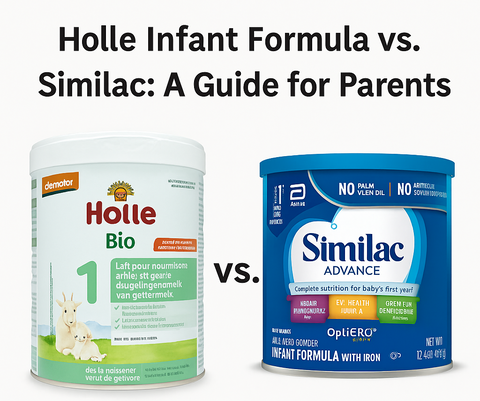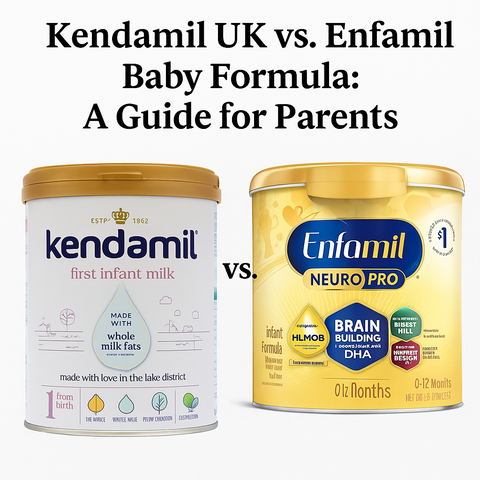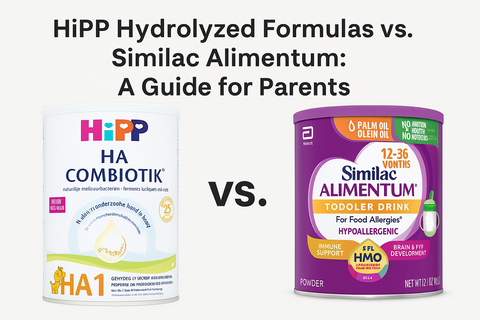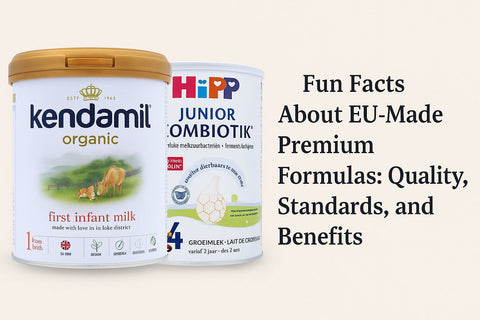Lactation Cookies: Boosting Milk Supply - Fact or Fiction?
The journey of motherhood is a remarkable one filled with incredible moments. Breastfeeding is a vital part of that experience, yet it can be challenging for some mothers. Many of those challenges are mainly related to milk supply. Lactation cookies have gained popularity in the quest to find natural ways to enhance lactation. These sweet treats are often a delicious solution to boost milk production. But the critical question is: Do lactation cookies genuinely work to increase milk supply?
Important note:
It’s important to note that lactation cookies offer potential nutritional benefits and promote maternal health. However, scientific evidence specifically evaluating their impact on milk supply remains limited. While lactation cookies can be an exciting addition to your postpartum nutrition plan, viewing them as supportive rather than miraculous solutions for low milk supply is vital. If you're facing challenges with milk production, consult your lactation consultant or healthcare provider.
Balanced Diet
While a balanced diet is essential, certain foods are believed to have lactogenic properties that can help enhance milk production. Here are five such foods to consider incorporating into your diet:

Avocados: These creamy delights are rich in healthy fats and essential nutrients like potassium and folate. The monounsaturated fats in avocados can support hormone production, which plays a role in milk supply.
Nuts: Almonds, in particular, are a breastfeeding mom's best friend. They're packed with protein, healthy fats, and fiber. Additionally, almonds contain phytoestrogens, which can mimic the effects of estrogen in the body and potentially boost milk production.
Garlic: While its pungent aroma might make you think twice, garlic is known for its lactogenic properties. It's believed that compounds in garlic can influence milk production, so don't be shy about adding it to your meals.
Fenugreek: Fenugreek seeds have long been used as a natural remedy to boost milk supply. They contain phytoestrogens and other compounds that may stimulate milk-producing glands.
Lactation Cookies: In this comprehensive blog, we'll deep dive into lactation cookies' science, dissect the key ingredients that make them, consider the anecdotal experiences of numerous breastfeeding mothers, and provide practical insights into how lactation cookies can fit into your postpartum nutrition plan. Friendly note: Just try not to eat them all at once (although no judgment if you do!).
The Science of Lactation Cookies

Hormonal Regulation: Prolactin and Oxytocin
At the heart of lactation are two important hormones: prolactin and oxytocin.
Prolactin: Prolactin is also known as the "milk-producing hormone." During pregnancy, prolactin levels rise steadily, preparing the mammary glands for milk production. However, it's after childbirth that prolactin becomes active. Its secretion surges in response to the removal of colostrum (the first milk) and continues to rise in parallel with the baby's feeding patterns. This hormone stimulates milk synthesis within the mammary alveoli, within the breast, where milk is produced. The more frequently a mother breastfeeds or pumps, the more prolactin is released, signaling to the body that milk production needs to be maintained or increased. How amazing!
Oxytocin: Oxytocin, often called the "love hormone," plays a dual role in lactation. While it contributes to the emotional bonding between mother and child, it also plays a critical role in milk ejection. When the baby latches onto the breast and begins to nurse, signals travel to the mother's brain, triggering the release of oxytocin. This hormone causes the mammary glands to contract, pushing milk into the ducts and out through the nipple, making it accessible to the infant.
Fun fact:
Oxytocin's release during breastfeeding also contributes to the deep sense of relaxation and connection many mothers experience during nursing sessions.
Mammary Gland Development
The mammary glands are a true marvel of nature. They undergo a stunning transformation during pregnancy, setting the stage for the miraculous production of breast milk.
During pregnancy, the mammary glands enlarge and become more complex. A network of ducts, alveoli, and milk-secreting cells forms. These structures are finely tuned to respond to hormonal cues to prepare for milk production.
As the pregnancy progresses, the mammary glands continue to grow, with the mammary alveoli filling with colostrum (a concentrated and highly nutritious form of milk). This colostrum is the baby's first food immediately after birth, providing essential antibodies and nutrients. How cool is that!
Following childbirth, the structural changes in the mammary glands continue. Regular breastfeeding or pumping ensures these changes are sustained, and the mammary alveoli are continually stimulated to produce milk. This dynamic process demonstrates the adaptability and responsiveness of the mammary glands to the infant's needs.
Milk Removal and Supply-Demand Principle
Efficient milk removal is the key to successful breastfeeding and maintaining a steady milk supply. The Supply - Demand principle, also known as "milk removal equals milk production," is at the core of this concept.
When a baby latches onto the breast and effectively removes milk during nursing, it signals to the body that more milk is needed. The mammary glands respond by increasing milk production to meet the demand. But, when milk is not regularly removed (as might occur if breastfeeding is infrequent or ineffective), the body sees this as reduced demand and subsequently decreases milk production.
This principle emphasizes the importance of frequent and effective breastfeeding or pumping sessions. It's also why lactation consultants often recommend feeding on demand early after birth to help establish a robust milk supply.
With their carefully chosen ingredients, lactation cookies can complement this process by providing essential nutrients and potentially supporting hormonal balance. By nourishing the mother's body and satisfying her cravings, these cookies can be a tasty and thoughtful addition to her breastfeeding journey, promoting both milk production and overall well-being.
So, this was the science part (sorry, we had to tell you these amazing facts about Mother Nature), and let’s get back to the cookies! ;)
Ingredients in Lactation Cookies
Lactation cookies are no ordinary baked goods; they are meticulously crafted with specific ingredients known for their potential to enhance milk production. This chapter will delve deeply into the magical ingredients that make lactation cookies popular.

There are five key ingredients found in these cookies:
- Flaxseed: The Omega-3 Connection
Flaxseed and Lactation. Flaxseed is celebrated for its abundance of omega-3 fatty acids, fiber, and phytoestrogens. Although there's no direct evidence linking flaxseed to increased milk supply, the presence of omega-3 fatty acids in flaxseed is significant. These fatty acids are vital for infant brain development and maternal well-being, indirectly affecting milk production.
- Oats in Lactation Cookies
Oats take center stage in lactation cookies, and rightly so. These grains are nutritional powerhouses with complex carbohydrates, fiber, and iron. Yet, there's more to oats than meets the eye. They contain saponins, plant compounds that might trigger the release of hormones, including prolactin.
Prolactin deserves a special mention because It's the hormone responsible for milk production. While research on oats' direct link to lactation is limited, their nutritional benefits make them a wise choice for breastfeeding mothers.
- Brewer's Yeast: A Nutrient-Rich Addition
Brewer's yeast, a byproduct of beer brewing, is another key ingredient in lactation cookies. It boasts an array of nutrients, including B vitamins, chromium, protein, and iron. Of these, vitamin B12 is crucial for lactation. It's believed that vitamin B12 supports the health and function of mammary glands, although scientific evidence directly linking it to increased milk supply is scarce.
- Fenugreek
Fenugreek, a well-known herb in traditional medicine, is often included in lactation cookies for its reputed ability to increase milk supply. We will discuss its role, dosage, and potential side effects.
- Herbs and Spices
Various herbs and spices like fennel, anise, and cinnamon are used to add flavor and for their potential lactation-boosting properties.
Lactation Cookies: Separating Fact from Fiction
The efficacy of lactation cookies in increasing milk supply primarily relies on anecdotal reports from breastfeeding mothers. Though studies specifically examining the effectiveness of lactation cookies are limited, research has delved into the individual ingredients commonly found in these cookies. This body of research suggests that ingredients like oats, brewer's yeast, and flaxseed possess nutritional properties that could support lactation and overall maternal health.
Real Stories of Motherhood
Countless breastfeeding mothers have shared positive outcomes after adding lactation cookies to their regular diet. Many report observing an increase in milk production and believe that these cookies have made a significant impact. While individual experiences vary, many stories of improved milk supply provide encouraging insights. It's essential to recognize the potential influence of the placebo effect in this context. In the case of lactation cookies, savoring them may serve as a gentle reminder for mothers to focus on self-care and hydration.
Are there any Risks and Concerns?
Yes. While lactation cookies are generally safe for consumption, it's crucial to be aware of potential risks and concerns associated with their use. Here are 4 things to take into consideration.
- Lack of Regulation
The lactation cookie industry operates with limited regulation. This leads to significant variations in the quality and effectiveness of different products. Choose reputable brands or make homemade lactation cookies using carefully selected ingredients to mitigate this risk.
- Allergies and Sensitivities: Tread Carefully
Lactation cookies may contain common allergens like nuts, wheat, dairy, and eggs. If you have known allergies or sensitivities, carefully select the ingredient list to ensure you are not consuming anything that could trigger an adverse reaction. Furthermore, some ingredients in lactation cookies may lead to gas, bloating, diarrhea, or constipation if consumed in larger quantities.
- Oversupply: Striking a Balance
Lactation cookies can boost milk supply, but they have the potential to cause oversupply. An oversupply of milk can lead to engorgement, painful clogged ducts, and unexpected leaks. If you find yourself in this situation, maintaining balance is essential. Regular pumping or hand expressing can alleviate discomfort, as producing more milk than your baby needs can be burdensome.
- Overconsumption: Part of a Comprehensive Approach
It's key to remember that lactation cookies should not be the sole solution for low milk supply. Overindulging these cookies without addressing the root causes of low milk supply may not effectively resolve the issue. Instead, consider them as part of a comprehensive approach to lactation support. To address these concerns and navigate the safest path for lactation support, discussing lactation cookies and their use with a healthcare provider is highly recommended!
Choosing Wisely: Selecting the Right Lactation Cookies
When choosing lactation cookies, here are some factors to consider to make informed decisions. Here are two tips:
- Trustworthy Brands: The Reliability Factor
Place your trust in established brands prioritizing quality and transparency in their manufacturing processes. Consider reading reviews or seeking recommendations from fellow breastfeeding mothers or healthcare professionals.
- Ingredient Analysis: A Closer Look
Examine the ingredient list of lactation cookies meticulously. Choose cookies containing beneficial ingredients such as oats, brewer's yeast, flaxseed, and other nutrient-rich components. Conversely, avoid cookies loaded with excessive amounts of refined sugars, artificial additives, or allergens that may trigger sensitivities.
By making wise choices and incorporating lactation cookies into a holistic approach to breastfeeding, you can harness their potential benefits while ensuring the well-being of both you and your little one.
Crafting Your Own Lactation Cookies at Home
Now that we've explored the science, anecdotes, and potential risks, let's have some fun and create your batch of lactation cookies. Here's a delicious recipe you can try at home:
Homemade Lactation Cookie Recipe
Ingredients:
- 1 cup of old-fashioned rolled oats
- 1/2 cup of brewer's yeast
- 1/2 cup of ground flaxseed
- 1/2 cup of whole wheat flour
- 1/2 cup of almond butter
- 1/4 cup of honey or maple syrup
- 1/4 cup of coconut oil
- 1/2 cup of chocolate chips (optional but delightful!)
- 1 teaspoon of vanilla extract
- 1/2 teaspoon of baking soda
- A pinch of salt
Instructions:
- Preheat your oven to 350°F (175°C) and line a baking sheet with parchment paper.
- In a large bowl, combine the oats, brewer's yeast, flaxseed, whole wheat flour, chocolate chips (if using), baking soda, and salt.
- In a separate microwave-safe bowl, heat the almond butter, honey or maple syrup, and coconut oil in the microwave for about 30 seconds or until they're easy to stir. Mix well, and add the vanilla extract.
- Pour the wet mixture into the dry mixture and stir until everything is well combined.
- Use a spoon to drop scoops of cookie dough onto your prepared baking sheet. These cookies won't spread much during baking, so shape them as you desire.
- Bake for about 12-15 minutes or until the edges are golden brown.
- Let them cool on the baking sheet for a few minutes before transferring them to a wire rack to cool completely. Enjoy your homemade lactation cookies with a glass of milk or your favorite lactation-boosting tea!
Conclusion
In conclusion, while scientific evidence regarding the effectiveness of lactation cookies is limited, the anecdotal evidence and positive experiences of breastfeeding mothers indicate that these cookies may offer potential benefits for milk supply. However, it's important to remember that they are not a magic solution and should be considered part of a diverse lactation support plan!
Breastfeeding is the best nutrition for your baby, as breast milk provides your child with all the essential nutrients they need for growth and development. If your child requires supplemental feeding, consult your pediatrician for appropriate guidance. Organic Formula Shop carries the world's best organic baby formula brands.
Contact
Contact our dedicated customer support team for expert advice and guidance tailored to your baby's needs. Our customer success team has earned hundreds of 5-star reviews from customers dedicated to helping you provide the best nutrition for your little one. Contact us here or shoot us an email at support@organicformulashop.com. We're here to help!
Happy Feeding!
Disclaimer: This information is based on general trends in breastfeeding and nutrition. It is not medical advice. Always consult your healthcare provider for personalized guidance on your breastfeeding journey.




